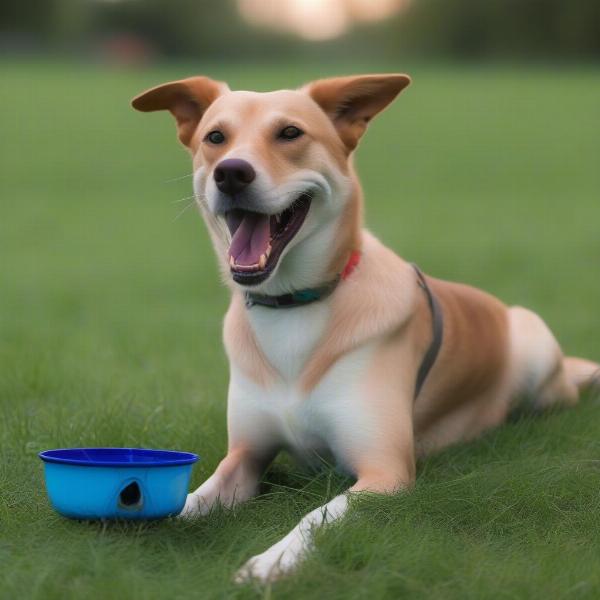A dog lure course machine, also known as a lure coursing system, provides a simulated hunting experience for dogs, mimicking the chase of prey. This exciting activity taps into a dog’s natural instincts and offers a fantastic outlet for their energy and drive. Whether you’re a seasoned dog owner or just starting your journey, understanding the nuances of a dog lure course machine can significantly enhance your canine companion’s physical and mental well-being. This article will explore the benefits, setup, safety considerations, and overall enjoyment a lure course machine can bring to you and your furry friend.
What are the Benefits of a Dog Lure Course Machine?
Lure coursing offers a multitude of benefits for dogs of all breeds and sizes. It provides excellent cardiovascular exercise, strengthening muscles and improving endurance. The mental stimulation derived from chasing the lure helps to alleviate boredom and reduce destructive behaviors. It’s a fantastic way to socialize your dog, especially in a controlled environment with other dogs participating in the activity. Moreover, lure coursing can build confidence and improve focus, contributing to a well-rounded and happy dog.
Setting Up Your Dog Lure Course Machine
Setting up a lure course machine requires careful planning and consideration. Choose a large, open space, ideally a fenced area, free from obstacles and hazards. The terrain should be relatively flat to minimize the risk of injury. Follow the manufacturer’s instructions meticulously for assembling the machine and laying out the lure course. Ensure the lure line is taut and securely anchored to prevent entanglement.
Safety First: Essential Precautions for Lure Coursing
While lure coursing is a thrilling activity, prioritizing safety is paramount. Begin with a thorough veterinary checkup to ensure your dog is physically fit for the exercise. Introduce your dog to the lure gradually, allowing them to acclimate to the movement and sound. Always supervise your dog during lure coursing and avoid overcrowding the course with multiple dogs simultaneously. Inspect the equipment regularly for any signs of wear and tear, and replace any damaged parts immediately.
Choosing the Right Lure Course Machine
Several factors influence the choice of a suitable lure course machine. Consider the size and breed of your dog, the available space, and your budget. Research different models and brands, comparing features such as speed settings, lure types, and durability. Reading reviews from other dog owners can provide valuable insights and help you make an informed decision.
Maximizing the Fun: Tips for an Enjoyable Lure Coursing Experience
Lure coursing can be a rewarding experience for both you and your dog. Keep the sessions short and engaging, especially initially, to prevent exhaustion. Positive reinforcement and encouragement can boost your dog’s confidence and enthusiasm. Vary the course layout periodically to maintain interest and challenge. Remember to provide plenty of fresh water and allow your dog ample rest after each session.
 Dog Resting After Lure Coursing
Dog Resting After Lure Coursing
Conclusion
A dog lure course machine offers a stimulating and enriching activity for dogs, promoting physical fitness, mental agility, and overall well-being. By understanding the benefits, setup, safety considerations, and choosing the right equipment, you can provide your canine companion with a safe and enjoyable lure coursing experience, strengthening your bond and enhancing their quality of life. Remember to always prioritize safety and consult with your veterinarian before starting any new exercise program.
FAQ
- What breeds are best suited for lure coursing? While sighthounds are naturally inclined towards chasing, dogs of all breeds can enjoy lure coursing.
- How often should I lure course my dog? Start with shorter sessions a few times a week and gradually increase frequency and duration as your dog builds stamina.
- Can puppies participate in lure coursing? It’s best to wait until a puppy’s growth plates have closed, usually around 12-18 months, before introducing them to lure coursing.
- What type of lure is used in a lure course machine? Common lure materials include plastic bags, fur, or fabric strips that mimic the movement of prey.
- Is lure coursing safe for senior dogs? Consult your veterinarian to assess your senior dog’s fitness level and determine if lure coursing is appropriate.
- How much space do I need for a lure course machine? Ideally, aim for a large, open space, at least 100 feet long and 50 feet wide, but smaller spaces can be accommodated with adjustments to the course.
- What are the signs of an overexerted dog during lure coursing? Watch for excessive panting, lagging behind, or reluctance to continue. Stop the session immediately if you notice these signs.
Related Articles
dog collar and bow
hot dogs machine
About ILM Dog
ILM Dog is your trusted international resource for comprehensive dog care and nurturing. We offer expert guidance on everything from breed selection and health care to training, nutrition, grooming, and finding the perfect products and accessories for your canine companion. Whether you’re a seasoned dog owner or just beginning your journey, we’re dedicated to providing you with the knowledge and resources you need to ensure your dog thrives. Contact us today for personalized advice and support: Email: [email protected], Phone: +44 20-3965-8624.